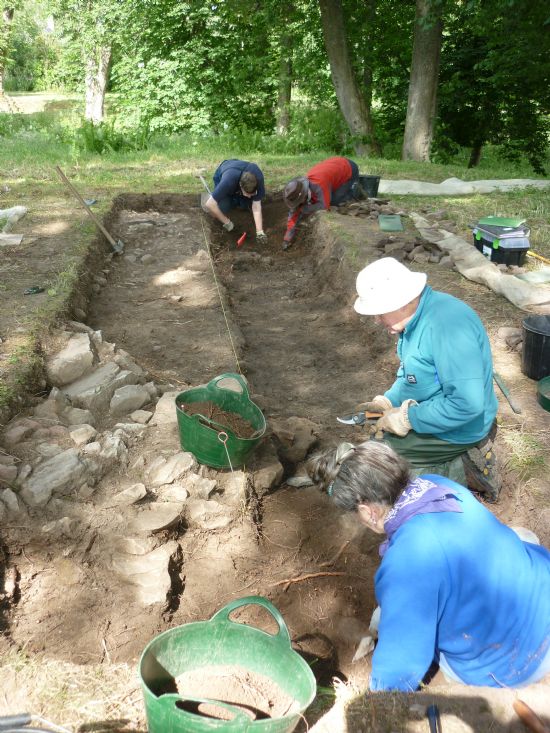Foulis mystery deepens
10 December 2012
 There’s a new mystery book being launched in Ross-shire with the enigmatic title ‘Delve into the Past’.
There’s a new mystery book being launched in Ross-shire with the enigmatic title ‘Delve into the Past’.
The unveiling will take place in the Cornerstone Cafe, Evanton on Thursday 13 December at 19.00. But the evening is guaranteed to leave those at the gathering even more mystified.
On that evening Lynne and Lachlan McKeggie will be discussing the ‘mystery of the Foulis Mound’. Is it a motte? Is it a meeting place? Is it a site of ritual burning?
ARCH (Archaeology for Communities in the Highlands) has been working at Foulis with a band of helpers over the last two summers, teaching volunteers new skills and trying to work out just what this mound is.
In the summer of 2012 their patient effort unearthed a large burnt patch of ground that contained animal bone and lots of charcoal. The excavators commented that their nostrils were filled with the smell of burning, but they could never have imagined that this had travelled across nearly 2000 years, concealed within earthen darkness and now released by their patient trowelling.
Five small pieces of bone and charcoal from this burnt area were sent for radio carbon dating and have turned up an incredible result. All the pieces are remarkably close in age, with dates between 31 and 147 AD - that’s Iron Age.
As Lachlan and Lynne McKeggie, the 2012 Delve dig supervisors commented, “We could never have imagined such an early date for this site. The view before the two years of excavation was that it might be a motte, the site of the former Foulis Castle. We were more inclined to think of it as a gathering, or meeting point. More like a Viking Thing, as no evidence of buildings had been revealed by the excavation work in season one. But this new evidence makes the site much earlier than envisaged, and has made the puzzle even greater.
“We’re fairly confident that the mound has been shaped by people and this area of heavy burning at the top of the mound contains a lot of animal bone, implying repeated cooking and dumping or perhaps one very large fire.”
All the bone finds were found lying very close together, suggesting that the area has been undisturbed for nearly 2000 years. The charcoal wood remains are slightly earlier than the bone, but as radio carbon dating shows when an organism died, this may represent the fact that the wood was seasoned for a while, and could even have been part of a structure. At this stage we can only speculate as to whether the site was used a number of times over a short period, or whether the excavation has revealed the result of a large fire burning old timbers and the cooking fresh meat.
There is evidence at other Iron Age sites, such as Birnie in Moray, of a final and deliberate clearing away of a building being accompanied by a farewell celebration, cooking and eating. More excavation might reveal if that is what happened at Foulis and might also help us to answer some of the many other questions about the site. We don’t know what happened between the Iron Age and the 1870’s seventeen hundred years later when it appears on a map. When was the mound shaped, what was the purpose of this shaping, what did people do here?
They’re all questions that only further excavation attempt to answer. ARCH is looking for some funding to help us re-visit the mound next year, and try to unravel some more of the mysteries of this fascinating site.
Foulis book Launch
Find out more about the mystery of Foulis and the joy of excavation at the launch of the Delve into the Past book on Thursday 13 December in Evanton Cornerstone Cafe at 7.00pm. Lachlan and Lynne McKeggie will be talking about Delve. There’ll be mulled wine and mince pies, tea, coffee and home baking - the perfect way to enjoy speculating on what two seasons of excavation mean, and what might be done next.
News Archive
- 12/08/2025 ARCH August 2025 Newsletter now available
- 30/03/2025 Dingwall Station Online display
- 27/02/2025 ARCH February 2025 Newsletter now available
- 05/09/2024 Exploring Norwegians in the Contin area in WWII
- 18/04/2024 Community Engagement and Volunteering - tips for success
- 10/04/2024 Celebrating ARCH Day - 13th April in Strathpeffer
- 27/02/2024 Funding awarded from NHLF for The Golspie Fishertown Project
- 19/02/2024 Exploring Dornoch Heritage course starting Thursday 22nd February 2024
- 08/02/2024 Bookings now open for Highland Heritage Day 2024
- 24/01/2024 ARCH Jan 2024 newsletter now available
